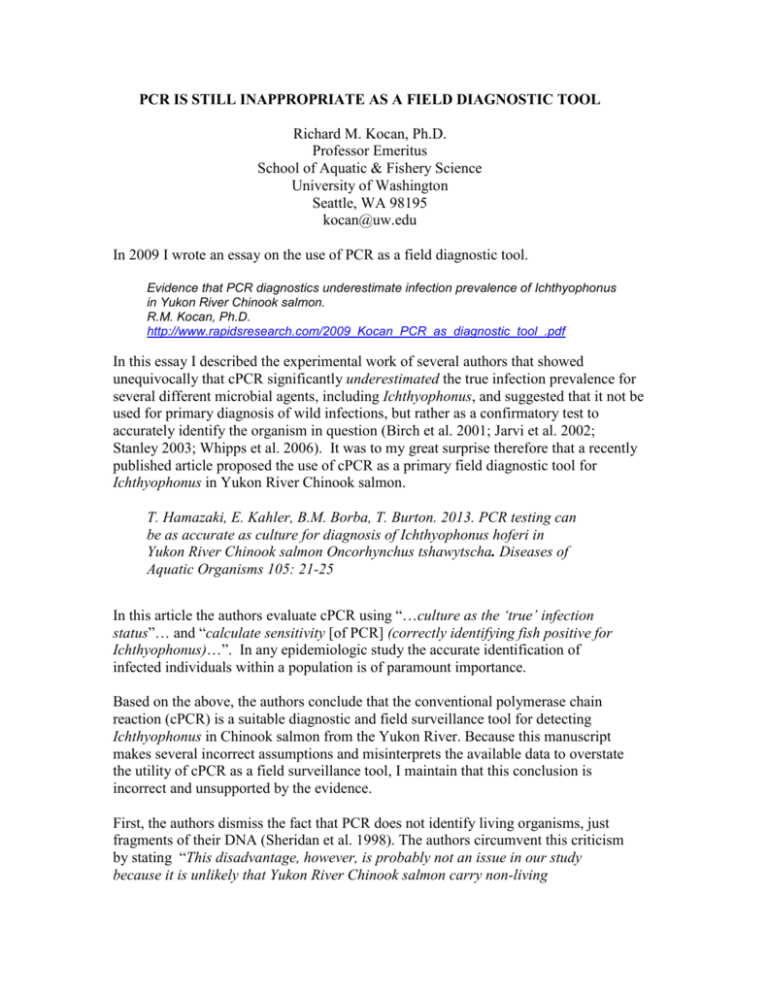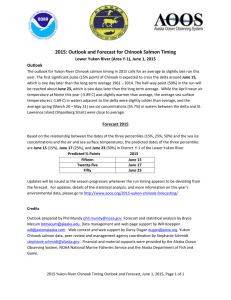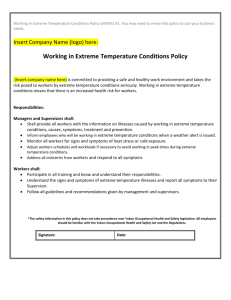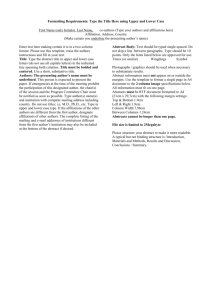PCR IS STILL INAPPROPRIATE AS A FIELD DIAGNOSTIC TOOL
advertisement

PCR IS STILL INAPPROPRIATE AS A FIELD DIAGNOSTIC TOOL Richard M. Kocan, Ph.D. Professor Emeritus School of Aquatic & Fishery Science University of Washington Seattle, WA 98195 kocan@uw.edu In 2009 I wrote an essay on the use of PCR as a field diagnostic tool. Evidence that PCR diagnostics underestimate infection prevalence of Ichthyophonus in Yukon River Chinook salmon. R.M. Kocan, Ph.D. http://www.rapidsresearch.com/2009_Kocan_PCR_as_diagnostic_tool_.pdf In this essay I described the experimental work of several authors that showed unequivocally that cPCR significantly underestimated the true infection prevalence for several different microbial agents, including Ichthyophonus, and suggested that it not be used for primary diagnosis of wild infections, but rather as a confirmatory test to accurately identify the organism in question (Birch et al. 2001; Jarvi et al. 2002; Stanley 2003; Whipps et al. 2006). It was to my great surprise therefore that a recently published article proposed the use of cPCR as a primary field diagnostic tool for Ichthyophonus in Yukon River Chinook salmon. T. Hamazaki, E. Kahler, B.M. Borba, T. Burton. 2013. PCR testing can be as accurate as culture for diagnosis of Ichthyophonus hoferi in Yukon River Chinook salmon Oncorhynchus tshawytscha. Diseases of Aquatic Organisms 105: 21-25 In this article the authors evaluate cPCR using “…culture as the ‘true’ infection status”… and “calculate sensitivity [of PCR] (correctly identifying fish positive for Ichthyophonus)…”. In any epidemiologic study the accurate identification of infected individuals within a population is of paramount importance. Based on the above, the authors conclude that the conventional polymerase chain reaction (cPCR) is a suitable diagnostic and field surveillance tool for detecting Ichthyophonus in Chinook salmon from the Yukon River. Because this manuscript makes several incorrect assumptions and misinterprets the available data to overstate the utility of cPCR as a field surveillance tool, I maintain that this conclusion is incorrect and unsupported by the evidence. First, the authors dismiss the fact that PCR does not identify living organisms, just fragments of their DNA (Sheridan et al. 1998). The authors circumvent this criticism by stating “This disadvantage, however, is probably not an issue in our study because it is unlikely that Yukon River Chinook salmon carry non-living Ichthyophonus.” This is an unproven assumption that has no basis in fact; it is purely an opinion of the authors. Second, the authors praise the accuracy (“sensitivity”), of cPCR by its ability to identify known culture-positive fish. Yet in Table 2 of their manuscript only 2 out of 7 samples (Emmonak 2004 & Salcha 2005) demonstrated a100% correspondence (sensitivity) between culture and PCR. The remaining 5 samples ranged from 76% to 92% correspondence (mean = 86.7%). The presence of Ichthyophonus in explant culture is unequivocal proof that the donor fish was infected, because there is no more certain way to demonstrate the presence of an organism than by seeing it. Consequently, for PCR to be equivalent to culture, PCR should detect every known culture-positive fish (100%), which is does not. Third, the authors downplay culture as impractical by citing the remoteness of the sampling locations, need for refrigeration, and slow processing time. To the contrary, these are non-issues since explant cultures have been successfully employed in remote locations throughout the world, including the Yukon River, where >3,000 tissue explant cultures were evaluated on-site from 1999-2003 (Kocan et al. 2004). Additionally, there is no need to refrigerate either the culture medium or the explant cultures because all components of the medium (Eagles Minimum Essential Medium and supplements) are stable at room temperature and the parasite will survive and grow at temperatures between 0° and 30°C, effectively negating the need for refrigeration or incubation. Finally, a trained technician at any time point after inoculation can read the explant cultures. An arbitrary incubation period of 14d at 15°C is often suggested for Ichthyophonus cultures, after which any cultures without Ichthyophonus schizonts are considered negative. However, the majority of cultures are positive by 5-7 days. Thus, a diagnosis can be made in the field within one week of sample collection. Throughout the manuscript, several false assumptions are made which lead to incorrect conclusions. Perhaps most importantly was the assumption that positive samples from the mouth of the Yukon River represented ‘light’ intensity infections and those from the Chena and Salcha Rivers represent ‘severe’ intensity infections. These are arbitrary designations that change as the infection progresses between the time the fish enter the Yukon River and when they reach their spawning steams. In fact, it has been shown that 60% of infected and diseased fish in the mainstem Yukon River die before reaching the Chena/Salcha Rivers, thereby leaving only survivors, which are most likely those fish with the lightest infections, not the heaviest as suggested by the authors. The authors go on to use these arbitrarily assigned infection intensities as evidence refuting the conclusions of a previously published manuscript (Whipps et al. 2006) where infection intensities were quantitatively scored by histopathology. In the Whipps paper, the authors concluded that the “Sensitivity of the [cPCR] test varied depending on the severity of the infection…” and “the sensitivity of this [cPCR] test when detecting light infection in heart tissue was lower (range between 50 and 100%)…” Even lower sensitivities were reported for low intensity infections in somatic muscle. However, Hamazaki et al. dismiss these results based on the arbitrarily assigned and unsupported infections intensities in the current paper, and the authors further dismiss the Whipps et al. sensitivity results as an ‘anomaly’ without providing any supporting evidence. Unrelated to the shortcomings of the study, it was surprising that the manuscript was able to pass peer and editorial review. In the RESULTS no actual data is presented, but rather the authors use terms such as “majority” and “few”, which are difficult to replicate in independent studies. If cPCR is equivalent to culture as a diagnostic tool then all positive cultures should also be cPCR-positive, which they are not. The authors also dismiss low sensitivity values for Emmonak 2006 and Chena 2006 as being the result of low sample numbers. Sensitivity of the test should be the same weather the sample number is “1” or “100”. The two tests either correspond or they do not; if they do not, then they cannot be equivalent. In conclusion, I still submit that cPCR is an inappropriate tool for field diagnosis and should be reserved for confirmation of the identity of the pathogen. References (see appendices in citation #4 for abstracts) 1. Birch, L., C.E. Dawson, J.H. Cornett, J.T. Keer (2001). A comparison of nucleic acid amplification techniques for the assessment of bacterial viability. Letters in Applied Microbiology 33(4): 296-301. 2. Jarvi, S.I., J.J. Schultz, C.T. Atkinson (2002). PCR diagnostics underestimate the prevalence of avian malaria (Plasmodium relictum) in experimentally-infected passerines. J. Parasitology 88(1): 153-158. 3. Sheridan, G.E.C., C.I. Masters, J.A. Shallcross, B.M. Mackey (1998) Detection of mRNA by reverse transcription-PCR as an indicator of viability in Escherichia coli cells. Applied Environmental Microbiology 64(4): 1313- 1318. 4. Rapids Research Center - Yukon River (2006) http://www.rapidsresearch.com/html/Ichthyophonus_disease.html 5. Whipps, C.M., T. Burton, V.G. Watral, S. St-Hilaire, M.L. Kent (2006). Assessing the accuracy of a polymerase chain reaction test for Ichthyophonus hoferi in Yukon River Chinook salmon Oncorhynchus tshawytscha. Diseases of Aquatic Organisms 68: 141-147.








